Defining Programs
To define programs, use the Maintain Programs (LM_PROG) component.
This topic provides overviews of program creation, modification, and deletion; lists prerequisites; and discusses how to:
Define program details.
Define program sections.
Enter section completion rules.
Specify attributes for programs.
Identify prerequisites for programs.
Specify equivalent courses and programs.
Add notes and attachments to programs.
Establish program security.
Clone programs.
Note: When you create a curriculum or certification program or modify certain aspects of an existing one, you must rebuild the catalog index before your changes are reflected in the learning catalog. See page discussions for lists of the modifications that require rebuilding the catalog index.
Pages Used to Define Programs
|
Page Name |
Definition Name |
Navigation |
Usage |
|---|---|---|---|
|
Search Programs |
LM_PRG_SRCH |
|
Search for or add a certification program or curriculum program. |
|
Maintain Programs - Details |
LM_PRG_PG |
|
Define general program information and details about payments, approvals, vendors, and external data. For certifications, also define completion and expiration information. |
|
Update Certifications |
LM_PRG_PUSH |
Click the Update Certifications button on the Maintain Program - Details page. The button appears for certification programs only. |
Enter the date on which the system will notify learners of revised certification requirements. |
|
Maintain Programs - Sections |
LM_PRG_SCN_PG |
|
Define sections for a program and the item details for each section. |
|
Section Rule Details |
LM_PRG_SCN_RULE_PG |
Click the Section Completion Rules link on the Maintain Programs - Sections page. |
Specify which sections of the program the learner must complete. |
|
Maintain Programs - Attributes |
LM_PRG_ATTRIB_PG |
|
Link a program to one or more categories and specify the relevant keywords and objectives. |
|
Maintain Programs - Prerequisites |
LM_PRG_PRQ_PG |
|
Identify other items, objectives, and programs that the learner must complete or that you recommend the learner complete prior to registering for this program. |
|
Maintain Programs - Equivalents |
LM_PRG_EQUIV_PG |
|
Identify courses and programs that are equivalent to a given program. |
|
Maintain Programs - Notes/Attachments |
LM_PRG_NANDA_PG |
|
Enter notes for a program and attach files. You can optionally include notes and attachments elsewhere in the system, such as for an item or class. |
|
Maintain Programs - Security |
LM_PRG_SEC_PG |
|
Identify the learning environment and learner groups that can access this program. |
|
Clone Programs |
LM_PRG_CLONE_PG |
Click the Clone link on the Details page. |
Copy a program and modify it to create a new program. |
Understanding Program Creation
You can create programs in two ways: you can add a new program, or you can search for an existing program, clone it, and modify the cloned version.
Adding a Program
To add a new program:
Access the Program Search page.
Click the Add Certification link or the Add Curriculum link.
Define program details such as pricing, approval rules, and—for certification programs—completion rules.
If you are defining a certification program that has a single set of expiration rules, you define the expiration rules at this time as well.
Define the sections that make up the program and, if applicable, the expiration rules for each section.
Note: To have a single course expire before the other sections of a program, you must create a section with that course only.
Specify program attributes—category relationships, keywords for catalog searches, and learning objectives.
Identify required and recommended prerequisites.
Identify equivalent courses and programs.
Add notes and attachments to the program.
Define security for the program.
Activate the program by changing its status on the Manage Programs - Details page from Pending to Active.
Update the catalog search index.
Cloning a Program
To clone an existing program:
Use the Program Search page to locate the program.
Click the Clone icon on the tool bar.
Enter a new program code.
This step may not be necessary depending on the settings on the Install Defaults component.
Identify the options to clone and click Continue.
When the Manage Program - Details page appears, make any changes that are needed.
Update the catalog search index.
Understanding Program Modifications
To modify a program:
Use the Program Search page to locate the program.
Update the program by modifying an existing effective-dated row or inserting a new effective-dated row.
Note: Correction mode is the default state for the Manage Programs component. If Correction mode is not enabled on your permission list for this component, the default mode is Update/Display All.
(Optional) Enter a revision code for the program on the Manage Programs - Details page.
(Optional) For certification programs only, you can automatically notify affected learners and their managers of program changes.
Click the Update Certification button at the bottom of the Manage Programs - Details page.
Enter the date on which to notify learners.
On the specified date, the system will send an email notification to learners whose program status is Registered, In Progress, or Completed. The notice alerts learners to the program change, but does not explain what modifications have been made. Learners can view new requirements on the self-service program detail pages.
(Optional) Update the certification status of affected learners.
In some cases, you may want to require that learners complete the new requirements immediately rather than during the next recertification period. You can use the group action feature of the Administer Program Roster component to update the certification status of those who have completed the program to Warning. Learners will able to see their new certification status on the self-service pages.
Understanding Program Deletions
To delete a program, two conditions must be met:
The program cannot be nested within another program.
No registration records can exist for the program.
Once a learner registers for a program you can no longer delete it, even if the learner is dropped from the program. You can, however, change the program status to Inactive on the Manage Programs - Details page. Inactive programs are accessible to administrators only.
To delete a program:
Use the Program Search page to locate the program.
Check for linked programs.
If this program is contained within another program, a Nested Program Relationship link appears near the top of the Manage Programs - Details page. Click the link to display the names of the parent programs. You must remove this program from the parent programs before you can proceed.
Click the Delete link on any page of the Manage Programs component.
Update the catalog search index.
Prerequisites
To use the following features, you must first activate them at the system level or for the administrator's learning environment:
Nested programs
This feature enables you to include a program within another program. To set the system-wide default, use the Allow Nested Program check box on the Install Defaults - Details page. The setting for the administrator's learning environment determines whether this feature is available when creating a program. One level of nesting is supported, meaning that program A can contain program B, but program B cannot contain other programs.
Cascading expirations
With cascading expirations, you can define expiration rules at the section level, rather than for a certification program as a whole. To define a program with this feature, the Allow Cascading Expirations option must be enabled for the administrator's learning environment.
Approvals
To define approval requirements for program registrations, the Program Registration check box must be selected on the Install Defaults - Programs page.
eSignature sign off
To require that administrators validate manual updates to a learner's certification status, the Require eSignature on Updates option must be activated for the administrator's learning environment.
Duplicate program codes
To assign the same program code to more than one program, the Program Code option on the Install Defaults - Details page must be set to Allowed. If it is set to Restricted by LE, each program that is associated with the same learning environment must be assigned a unique code.
Note: The Install Defaults component also controls conditions for updating and tracking a learner's certification status.
Maintain Programs - Details Page
Use the Maintain Programs - Details page (LM_PRG_PG) to define general program information and details about payments, approvals, vendors, and external data.
For certifications, also define completion and expiration information.
Image: Maintain Programs - Details page (1 of 2)
This example illustrates the fields and controls on the Maintain Programs - Details page (1 of 2).
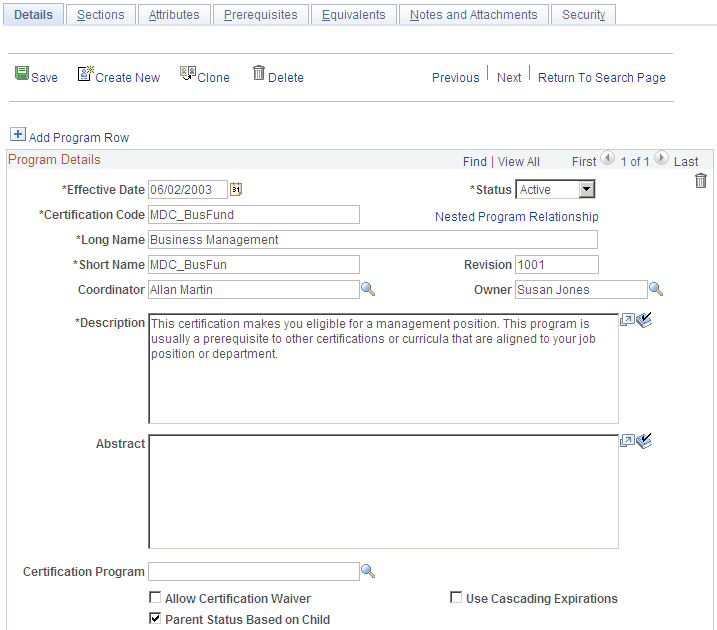
Image: Maintain Programs - Details page (2 of 32)
This example illustrates the fields and controls on the Maintain Programs - Details page (2 of 2).
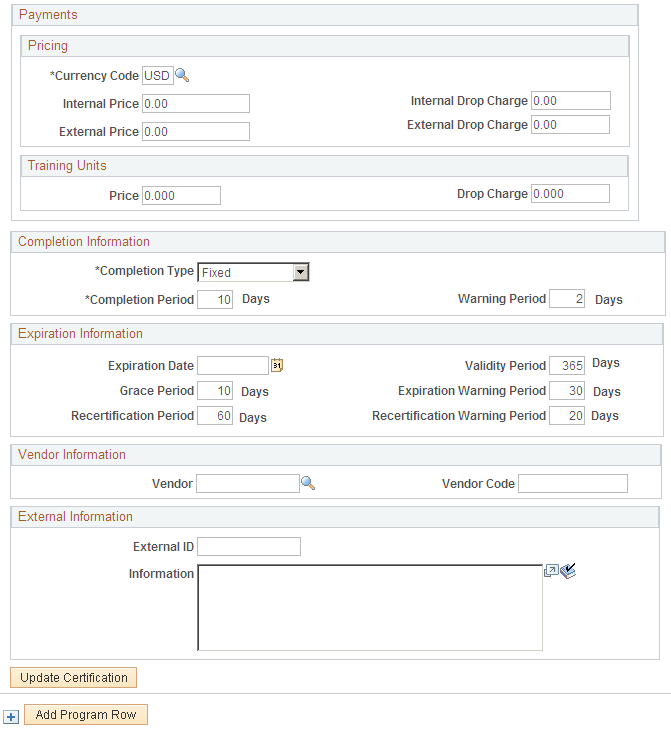
Note: When you modify the Certification Code, Curriculum Code, Effective Date, Long Name, Short Name, Status, Certification Program, or Expiration Date fields, you must rebuild the catalog index before the changes are reflected in the learning catalog. Changes to approval and payment information also require that you rebuild the index.
See Updating the Catalog Indexes.
Program Details
| Certification Code or Curriculum Code |
Enter a code for the program. The system displays the code in the catalog. You may be required to enter a unique program code, depending on the program code option on the Install Defaults - General page. |
| Effective Date |
The program displays in the catalog on or after the effective date, provided that the status is set to active. |
| Nested Program Relationship |
This link is useful after you define a program. It only appears when this program is contained within another program. Click to see the names of the parent programs. Clicking a parent program opens the Items component so that you can view and edit that program. Because you cannot delete a program that is nested within another program, this link provides a convenient way to check for and remove the association with parent programs before you delete this program. |
| Long Name and Short Name |
The system displays these program names in the catalog. For recertification programs, it's recommended that you include the term recertification in the name so that learners can easily spot these programs in the catalog. |
| Status |
Possible values are: Pending: Select to indicate that this program is under construction and not yet published. These programs are only accessible by administrators. When you create a new program, the system automatically sets the status to this value. Active: Select to indicate that this program is ready to be published in the catalog, making it available to learners for registration. The system displays only the programs with active status and valid effective date in the catalog. For this program to appear in the catalog search, you must regenerate the catalog index. Inactive: Select to indicate that this program is no longer in use. These programs are only accessible by administrators. |
| Coordinator |
Select as a coordinator for this program an instructor within your learning environment, as defined on the Instructor page. |
| Revision |
To track different revisions of this program, enter a distinguishing value. For example, if you revise a program twice you might enter A for the original, B for the first revision, and C for the second revision. It is recommended that you also change the effective date if you change a revision because effective dating provides true revision control. |
| Owner |
As a reference, enter the name of the person responsible for constructing or managing this program. |
| Description |
Enter a description of the program, such as topics covered and intended audience. This description is available to learners through the catalog. |
| Abstract |
The abstract does not appear in the catalog. |
| Certification Program |
If you are creating a certification program, leave this field blank. If you are creating a recertification program, enter the name of the original certification that this recertification applies to. For example, if you are defining a recertification program for Sales Director called Sales Director Refresher, you would enter Sales Director in this field. You can define multiple recertification programs for a single certification program. This field is hidden when you select Use Cascading Expirations. |
| Approval Type |
If registration in the program requires approval, select the approval process definition here. The approval process definition defines the conditions under which registration must be approved and who must give their approval. This field only appears when program registration approvals are enabled on the Install Defaults - Programs page. |
| Special Approver |
This field is applicable when you select a value in the Approval Type field. You can designate any Enterprise Learning Management user as a special approver for registration. The approval process definition selected in the Approval Type field determines when the person named here is required to approve the registration. If the approval process does not require a special approver, the system ignores the name entered here. |
| Allow Certification Waiver or Allow Curriculum Waiver |
Select to permit a manager or administrator to waive this program for a learner using the supplemental learning feature. (Administrators can always use the program roster to waive programs regardless of the selection here.) With a waived program, the learner gets credit for having the knowledge or experience equivalent to this program without having to register for it and complete it. The system marks the program as waived for the learner. When a program is waived, the system automatically assigns learning objectives that are associated with the program to the learner in Met status. A program waiver does not translate to waivers for the items that make up the program. See Understanding Supplemental Learning. Deselect this check box to indicate that learners cannot get a waiver for this program. |
| Use Cascading Expirations |
(Certification programs only.) Select if you want to define expiration rules at the section level. Each section of courses can have its own expiration rules, which enables a single section of the program to expire rather than the entire certification. The check box appears only when the Allow Cascading Expiration option is enabled for the administrator's learning environment. When selected, the Expiration Information group box on this page is hidden and appears on the Sections page instead. Note: When you select this check box, the system selects the Parent Status Based on Child check box and makes it unavailable to deselect. |
| Parent Status Based on Child |
Select to have the status of parent programs be based on the status of child programs. For example, if you select this check box and a child program expires, the parent program also expires. If you deselect this check box, the status of parent program is not based on the status of child programs. With this check box deselected, the system sets the status of parent programs as follows:
Note: This check box is available only if you select the Allow Nested Programs check box on the Install Defaults - Programs page. If you select the Parent Status Based on Child check box on the Install Defaults - Programs page, the Parent Based on Child check box on the Maintain Programs - Details page is selected by default. |
| Require eSignature on Updates |
Select to indicate that manual updates to a learner's program status require eSignature validation. When an administrator uses the program roster to update a learner's program status, the system will prompt for the user's Enterprise Learning Management password. The check box appears only when the Require eSignature on Updates option is enabled for the administrator's learning environment. |
Pricing
Use this group box to enter the base price that the learner must pay to register for the program. When a learner registers for a program, the system tracks the learner's payment method and payment details. The price for the program is independent of the price for items that make up the program. The learner pays for each separately. No discounts exist for items or objectives completed before program registration. No charges are incurred for waiving a program.
Training Units
Completion Information
Completion information applies to certifications only.
Expiration Information
Expiration rules apply to certifications only. Use the fields in this group box to define the expiration rules for the certification program as a whole. When the Use Cascading Expirations check box is selected, this group box is hidden and you define expiration rules for each section of the program on the Sections page.
Note: The certification expiration date defined by the Validity Period or Expiration Date field is the soft expiration date that the system communicates to the learner in notifications. Actual certification expiration (hard expiration), occurs after both the recertification and the grace periods have elapsed.
Vendor Information
External Information
Update Certification
As certification requirements change, administrators can publish new or revised requirements to learners whose certification status is Registered, In Progress, Completed, or Warning. After updating the requirements, click the Update Certification button to access the Push Information page. This page lists the number of learners who are currently registered or who have completed the program. You can enter a date for sending an email notification to affected learners and their managers. The program's effective date appears by default.
The email does not describe the nature of the change, so you may want to use the email feature accessed through the program roster pages to send a second email that highlights the new or revised requirements.
Note: We recommend you insert a new effective date before updating existing requirements, if you want to track revisions to the program. Otherwise, all learners registered in the program will need to complete the new requirements once their status has changed.
Maintain Programs - Sections Page
Use the Maintain Programs - Sections page (LM_PRG_SCN_PG) to define sections for a program and the item details for each section.
Image: Maintain Programs - Sections page
This example illustrates the fields and controls on the Maintain Programs - Sections page.

Each program must include at least one section. Each section can include one or more courses or another program. To create a section that contains courses, click the Add Item Section link at the bottom of the page and identify the items to include. To create a section that includes a program, click the Add Program Section link and identify the program to include. (Separate sections are required for items and programs.) Classes are part of each course and cannot stand alone within a program.
Note: The Add Program Section link appears only when the nested program option is activated for the administrator's learning environment.
Section Details
Each item section must include at least one item. A program section can include only one program.
Item Details
Use this group box to select the items or program for the section.
Expiration Information
Expiration rules apply to certification programs only. This group box appears for item sections when the Use Cascading Expirations check box is selected on the Maintain Programs - Details page.
Enter the expiration rules that pertain to this section only. The fields are similar to the expiration fields on the Maintain Programs - Details page; however, the rules you define here apply to this section only.
Section Rule Details Page
Use the Section Rule Details page (LM_PRG_SCN_RULE_PG) to specify which sections of the program the learner must complete.
Image: Section Rule Details page
This example illustrates the fields and controls on the Section Rule Details page.
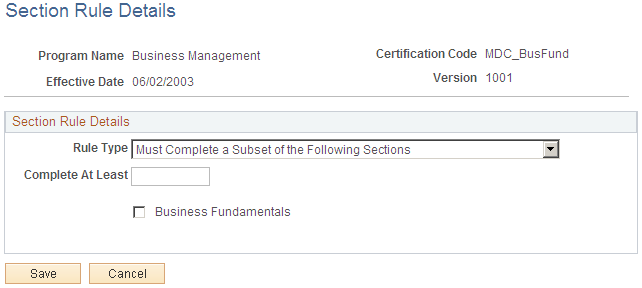
Maintain Programs - Attributes Page
Use the Maintain Programs - Attributes page (LM_PRG_ATTRIB_PG) to link a program to one or more categories and specify the relevant keywords and objectives.
Image: Maintain Programs - Attributes page
This example illustrates the fields and controls on the Maintain Programs - Attributes page.

Note: When you add, remove, or modify categories, keywords, or objectives, you must rebuild the catalog index before the changes are reflected in the learning catalog.
See Updating the Catalog Indexes.
Category Relationships
Select the categories under which you want to list this program in the learning catalog.
See Defining Learning Categories.
Keywords
Keywords help users locate this program when searching the catalog.
| Keyword Type |
Select the keyword type or category. |
| Keyword |
Select a keyword for this program. You can only select keywords that belong to the selected keyword type. |
Objectives
Identify the objectives and, if applicable, corresponding proficiency levels that learners meet by completing this program. Learners receive credit for meeting the objectives that have been directly assigned to them.
A program's objectives have no relation to its constituent course objectives. The objectives at either level function independently of one another. Define objectives on the Objectives page.
Maintain Programs - Prerequisites Page
Use the Maintain Programs - Prerequisites page (LM_PRG_PRQ_PG) to identify other items, objectives, and programs that the learner must complete or that you recommend the learner complete prior to registering for this program.
Image: Maintain Programs - Prerequisites page
This example illustrates the fields and controls on the Maintain Programs - Prerequisites page.
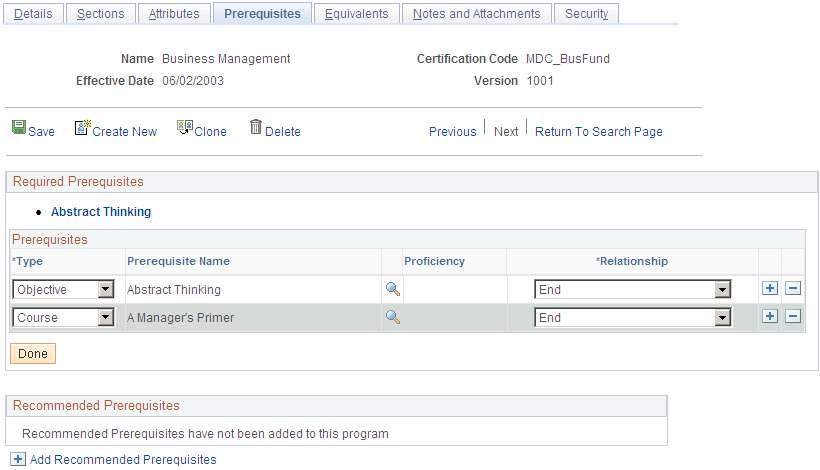
Required Prerequisites
The program registration process checks that the learner has met all required prerequisites for this program, before confirming the learner's registration. The registration process does not check prerequisites for courses within a section of a program because the course prerequisites function independently of the program prerequisites. Administrators can override prerequisites during group and mass enrollment. Managers cannot override prerequisites for a learner directly, but can use the Supplemental Learning page to give learners waivers on courses, objectives, and programs.
To add a prerequisite for the program, click the Add Required Prerequisites link and enter the prerequisites.
Recommended Prerequisites
These fields are similar to the Required Prerequisites fields. Use them to select courses, objectives, and programs that you recommend learners complete before taking the current program. Recommended prerequisites that the learner does not meet do not prevent the learner from registering for the program.
Maintain Programs - Equivalents Page
Use the Maintain Programs - Equivalents page (LM_PRG_EQUIV_PG) to identify courses and programs that are equivalent to a given program.
Image: Maintain Programs - Equivalents page
This example illustrates the fields and controls on the Maintain Programs - Equivalents page.
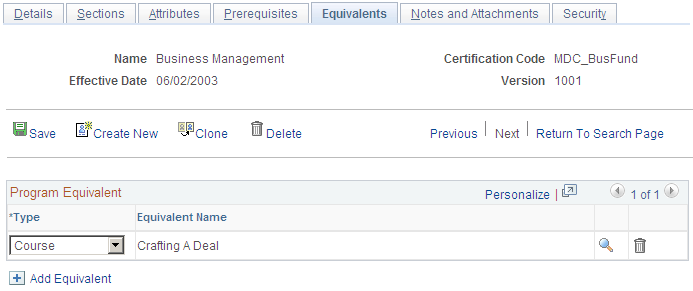
Select the courses or programs that are equivalent to this one. When a program or course has a prerequisite, learners can complete an equivalent program or course to meet the prerequisite.
If the learner completes more than one equivalent item or program, the system refers to the item or program that was completed most recently, for the certification requirement.
Maintain Programs - Notes/Attachments Page
Use the Maintain Programs - Notes/Attachments page (LM_PRG_NANDA_PG) to enter notes for a program and attach files.
Image: Maintain Programs - Notes/Attachments page
This example illustrates the fields and controls on the Maintain Programs - Notes/Attachments page.
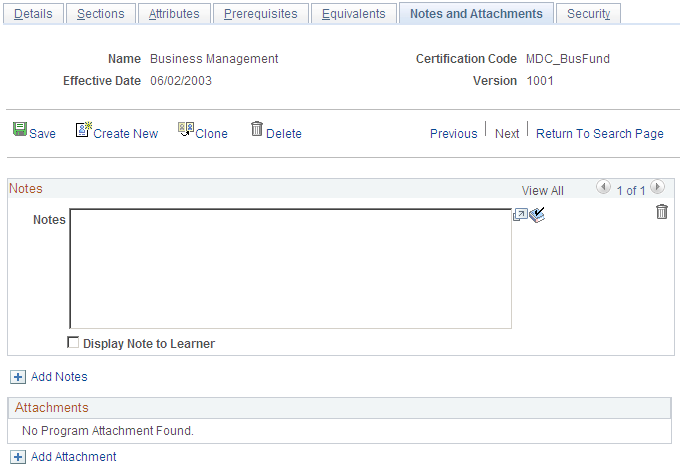
Notes
Enter any notes about the program and, if applicable, select the Display Note to Learner check box for the note.
Attachments
To add an attachment, click the Add Attachment link. Then either enter the path to and the name of the attachment, or click the Browse button to locate the attachment, and click the Upload button. After you upload the attachment, the system displays the attachment file name in the description field. You can edit this description.
To display attachments to the learner, select the Display check box next to the attachment description.
To delete an attachment, select the check box next to the attachment description and click the Delete Attachment button.
Other aspects of attachments are discussed in the Managing Classes topics.
Note: Your system configuration determines the size of the files that you can attach.
.
Maintain Programs - Security Page
Use the Maintain Programs - Security page (LM_PRG_SEC_PG) to identify the learning environment and learner groups that can access this program.
Image: Maintain Programs - Security page
This example illustrates the fields and controls on the Maintain Programs - Security page.
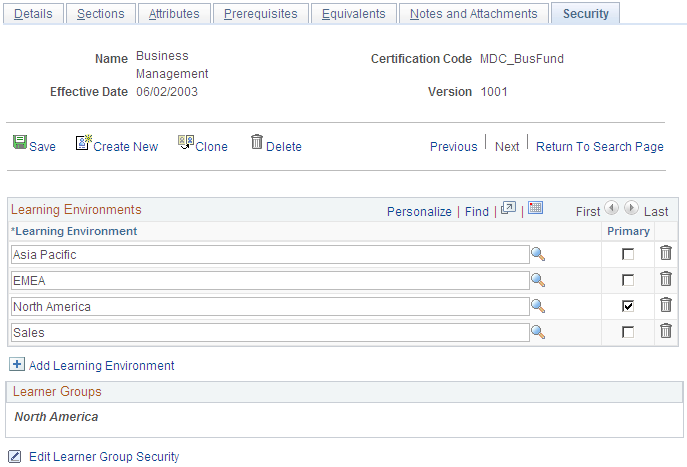
Note: When you add or remove learning environments or learner groups, you must rebuild the catalog index for programs before the changes are reflected in the learning catalog.
See Updating the Catalog Indexes.
Learning Environments
Use these fields to specify the learning environments for which this program is valid.
Learner Groups
Identify which learner groups can access this program in the catalog. The administrator can select from the learner groups that have been defined for any of the learning environments associated with the program. To access this program in the catalog, a learner must meet the group membership criteria that you define here.
Learner groups assigned to the program are not automatically assigned to constituent courses and programs. For example, you might grant the North America learner group access to the Professional Development curriculum, but only a subset of learners within the North America group may be able to complete the program. This is possible if only some members of the North America group are also members of learner groups associated with the courses in the program. Assigning a learner group to the program does not mean that all learners in that group will have access to all items and programs within the program.
It is the responsibility of the administrator to ensure that there are no conflicts or inconsistencies between learner groups assigned to the program and learner groups assigned to constituent courses and programs.
To add learner groups, click the Add Learner Group Security link.
Clone Programs Page
Use the Clone Programs page (LM_PRG_CLONE_PG) to copy a program and modify it to create a new program.
Image: Clone Programs page
This example illustrates the fields and controls on the Clone Programs page.
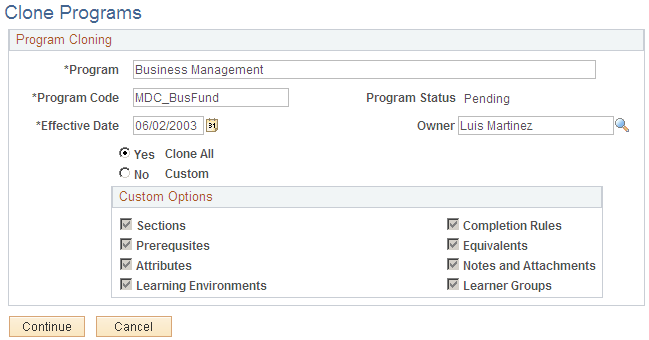
See Understanding Program Creation.
Custom Options
The check boxes in this section become available when you select the Custom option. Select the program attributes that you want to copy from the existing program to the new program. When you click Continue, the Details page appears with the cloned data, which you can update.
Note: Selecting Sections is an all or none option; either all the sections are cloned or none of the sections are cloned. If you do not select Learning Environments, the new program inherits your learning environment and corresponding learner groups.